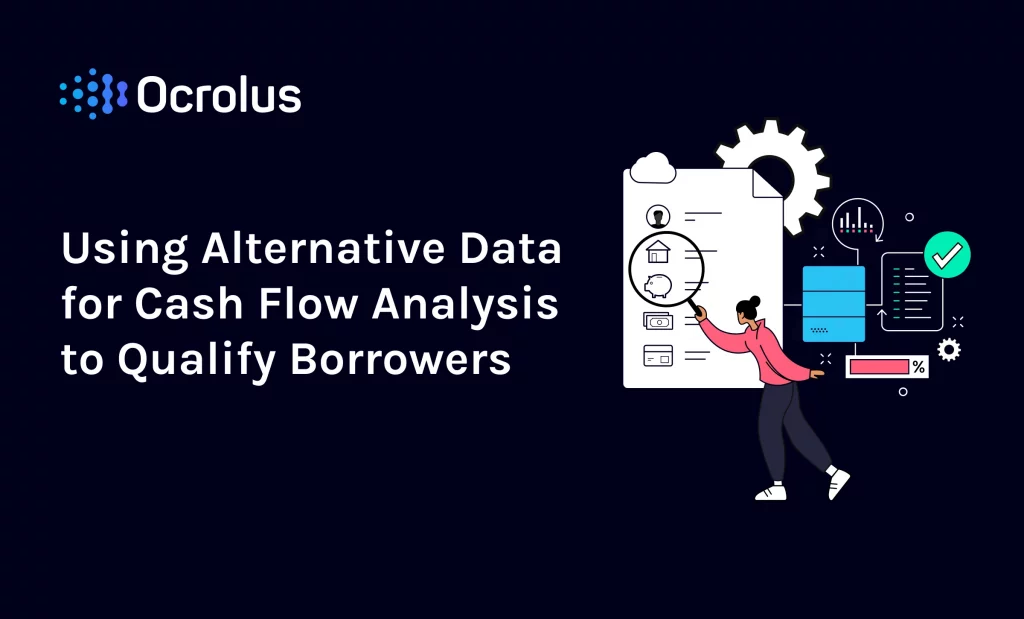This website uses cookies so that we can provide you with the best user experience possible. Cookie information is stored in your browser and performs functions such as recognising you when you return to our website and helping our team to understand which sections of the website you find most interesting and useful.
Using Alternative Data for Cash Flow Analysis to Qualify Borrowers

One of the primary uses of alternative data is the review of bank statements to determine a company or individual’s assets and cash management over an extended period of time.
You might remember when a relatively quiet yet significant announcement was made a few years ago by regulators in Washington regarding the use of alternative data in underwriting consumer loans. Almost 60 million people in the U.S. have found it challenging to obtain financing for automobiles, furniture and other consumer purchases because historic credit scoring models do not adequately represent their ability to repay.
Issues that Successful Fintech Lenders Have Learned and Addressed
This news points to two key issues that successful fintech lenders have learned and addressed:
- First, the goal of underwriting is to obtain as much information as possible in an organized methodology to determine credit-worthiness. Credit scores are just one amalgamated index to indicate the ability to repay an obligation. It doesn’t tell the whole story, but traditional lenders have used it because it is an expedient summary for many borrowers.
So much information can be gleaned from supporting documents like bank statements and pay stubs to indicate the financial responsibility of borrowers. In our work with hundreds of fintech lenders in the business lending space, we have seen how their integration of document-based data for cash flow analysis has enabled them to increase productivity and profitability in online lending. Notably, we’re starting to see the adoption of similar methods for consumer lending.
- Second is the importance of protecting consumer data and determining its veracity. In other words, both the lender and the consumer need to be sure that data is protected and validated. The potential for fraud on both sides is important to address. We have developed an infrastructure for lenders that can detect altered documents like bank statements, and in conjunction with business partners like SentiLink, can also expose behavior indicative of synthetic identity.
The Use of Alternative Data in Lending
The use of alternative data to expand the pool of potential borrowers juxtaposed with the need to prevent fraudulent loans is also addressed in a 2018 Experian survey, conducted by Aite Group, to discover how and why lenders use alternative data. Two key findings from the Experian report:
- The majority of lenders say finding qualified borrowers over the next two years will be challenging. (47% selected “extremely or very challenging, 32% said moderately challenging.) The expectation is that competition among depository institutions and the growing number of fintech lenders for a slower-growing pool of traditionally qualified borrowers will drive up customer acquisition costs while reducing margins.
- 63% of credit executives surveyed believe the threat of external fraud will be extremely or very challenging in future years. Incorporating more documentation including bank statements, utility bills and pay stubs can help lenders identify potential borrowers while screening out potentially fraudulent applications.
All of this is outside the realm of traditional credit scoring because it paints a more detailed picture. In effect, consumer and mortgage lenders now have the ability to easily deploy an infrastructure that commercial fintechs have developed for small business lending. This creates a win-win scenario, discerningly broadening the lender’s opportunity funnel while enabling more qualified applicants to get the funding they need.
The Benefit of Cash Flow Data for Loan Underwriting
One of the primary uses of alternative data is the review and verification of bank statements to determine a company or individual’s assets and cash management over an extended period of time. FinRegLab recently published a study of cash flow analytics variables and credit scores using data from six non-bank financial services providers – Accion, Brigit, Kabbage, LendUp, Oportun, and Petal. Here were some of their findings:
- The predictiveness of the cash-flow scores and attributes was generally at least as strong as the traditional credit scores and credit bureau attributes studied.
- The cash flow scores and attributes appeared to separate risk in somewhat different ways than traditional scores and attributes, such that the cash flow data frequently improved the ability to predict credit risk among borrowers
- When divided into subgroups based on likely race, ethnicity, and gender, the degree to which the cash-flow data predicted credit risk appeared to be relatively consistent across subpopulations.
The report points to the usefulness of bank statements as a key source of credit-worthiness. Therefore, the ability to access, extract and analyze bank statement content will prove to be a competitive differentiator for all lenders.
Find out how you can analyze and verify bank statements faster with automation from Ocrolus or book your demo today.
# # #
Elliot Storey is Partnership Manager for Ocrolus, a leading fintech infrastructure company that transforms documents into actionable data.





